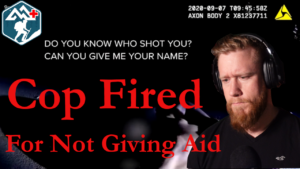Denver Officer Fired for Not Giving Medical Aid

A Denver Police Officer has been fired for failing to render aid to a mortally wounded gunshot victim.
On Sept. 7, 2020, Denver Police officer Dewayne Rodgers and his back up officer, David Clough responded to a report of shots fired in the vicinity of an apartment complex located at 10150 E. Harvard Ave.
Upon arriving at the scene of the shooting, the officers discovered 18-year-old Jalonte Jones lying in the parking lot of the apartment complex, suffering from gunshot wounds to his lower body.
Footage from Rodgers body cam shows him standing over Jones, and repeatedly asking his name and who shot him, but does not show him attempting to give aid to the wounded youth at any point.
According to the Denver Post:
“In his report from the night of the incident, Rodgers wrote that the victim’s pants were so bloody that he couldn’t tell which leg was injured. Rodgers later told investigators that he completed first aid and tourniquet training classes and generally carried a tourniquet on duty, but that he’d forgotten it that night.”
According to a report by investigators, Rodgers stated:
“I made the determination that I should not touch him, because he’s in dire straits at this point. He’s bleeding out. He can barely move, and he can barely talk to me at all. With all that going on, I made the determination that I can’t touch him. I didn’t want to fish around for the injury and do more harm.”
Officer Rodgers was fired on November 22, 2020, per the recommendation of Dever Police Chief Paul Pazen, and affirmed by Mary Dulacki, the Denver Department of Public Safety’s chief deputy executive director, who said:
“Officer Rodgers’ claim that he was concerned about aggravating the injury cannot excuse the lack of care he demonstrated since the foreseeable outcome of failing to render aid was death, which significantly outweighs any concern of aggravating an injury.”
Rendering aid in a hostile environment, with an active threat like that of a shooter still on the loose, is a dangerous task. Taking care of a victim on the streets of a large city like Denver is much different than taking care of patients in a well-it and staffed Emergency Room.
What are some of the problems and solutions of the above scenario?
- Officer Rodgers claimed there was so much blood that he didn’t know where the injury was located.
- Trauma shears were invented to solve this exact problem. An essential piece of kit for anyone doing dangerous work, in trauma care shears are used to remove the clothing of the victim so the precise location of the wound can be observed and properly treated. Had Officer Rodgers cut away Jones clothes, he would have known where the bleeding was coming from.
- Rodgers went on to claim that since he didn’t know the location of the wound, he feared causing an increase in bleeding and causing the victim to expire more quickly.
- This is a good example of how indecision can cause fatalities. In trauma medicine, something is better than nothing. The casualty will die if nothing is done anyway, so you aren’t likely to be making things worse. If this is a concern for you, discard that fear by getting trained on how to take care of life-threatening wounds. Mountain Man Medical provides a FREE online class, so you know what you’re doing.
- Rodgers also admitted to not having his tourniquet on him at the time.
- Tourniquets are important life saving tools and anyone in a dangerous job should have access to one. If you do dangerous things, have quality medical gear ready.
However, you don’t need a Tourniquet to save a life. If Officer Rodgers had cut away the Jones pants, located the worst bleeding wound, and applied direct pressure over it, there is a chance he could have saved the life of the teenager.
Moral of the story: If you don’t have a TQ, direct pressure over the worst bleeding wound could save a life.
